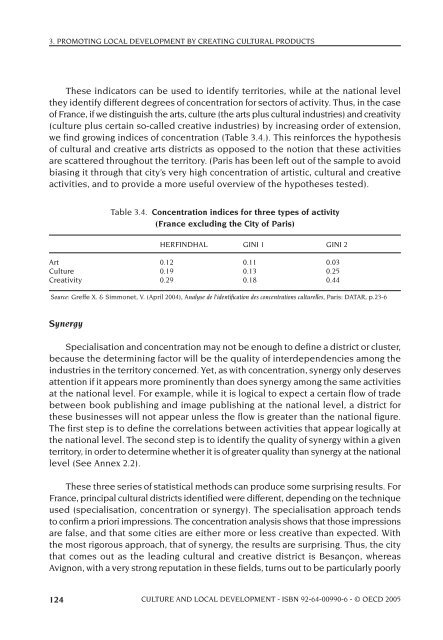OECD Culture and Local Development.pdf - PACA
OECD Culture and Local Development.pdf - PACA
OECD Culture and Local Development.pdf - PACA
Create successful ePaper yourself
Turn your PDF publications into a flip-book with our unique Google optimized e-Paper software.
3. PROMOTING LOCAL DEVELOPMENT BY CREATING CULTURAL PRODUCTS<br />
These indicators can be used to identify territories, while at the national level<br />
they identify different degrees of concentration for sectors of activity. Thus, in the case<br />
of France, if we distinguish the arts, culture (the arts plus cultural industries) <strong>and</strong> creativity<br />
(culture plus certain so-called creative industries) by increasing order of extension,<br />
we find growing indices of concentration (Table 3.4.). This reinforces the hypothesis<br />
of cultural <strong>and</strong> creative arts districts as opposed to the notion that these activities<br />
are scattered throughout the territory. (Paris has been left out of the sample to avoid<br />
biasing it through that city’s very high concentration of artistic, cultural <strong>and</strong> creative<br />
activities, <strong>and</strong> to provide a more useful overview of the hypotheses tested).<br />
Table 3.4. Concentration indices for three types of activity<br />
(France excluding the City of Paris)<br />
HERFINDHAL GINI 1 GINI 2<br />
Art 0.12 0.11 0.03<br />
<strong>Culture</strong> 0.19 0.13 0.25<br />
Creativity 0.29 0.18 0.44<br />
Source: Greffe X. & Simmonet, V. (April 2004), Analyse de l'identification des concentrations culturelles, Paris: DATAR, p.23-6<br />
Synergy<br />
Specialisation <strong>and</strong> concentration may not be enough to define a district or cluster,<br />
because the determining factor will be the quality of interdependencies among the<br />
industries in the territory concerned. Yet, as with concentration, synergy only deserves<br />
attention if it appears more prominently than does synergy among the same activities<br />
at the national level. For example, while it is logical to expect a certain flow of trade<br />
between book publishing <strong>and</strong> image publishing at the national level, a district for<br />
these businesses will not appear unless the flow is greater than the national figure.<br />
The first step is to define the correlations between activities that appear logically at<br />
the national level. The second step is to identify the quality of synergy within a given<br />
territory, in order to determine whether it is of greater quality than synergy at the national<br />
level (See Annex 2.2).<br />
These three series of statistical methods can produce some surprising results. For<br />
France, principal cultural districts identified were different, depending on the technique<br />
used (specialisation, concentration or synergy). The specialisation approach tends<br />
to confirm a priori impressions. The concentration analysis shows that those impressions<br />
are false, <strong>and</strong> that some cities are either more or less creative than expected. With<br />
the most rigorous approach, that of synergy, the results are surprising. Thus, the city<br />
that comes out as the leading cultural <strong>and</strong> creative district is Besançon, whereas<br />
Avignon, with a very strong reputation in these fields, turns out to be particularly poorly<br />
124 CULTURE AND LOCAL DEVELOPMENT - ISBN 92-64-00990-6 - © <strong>OECD</strong> 2005














